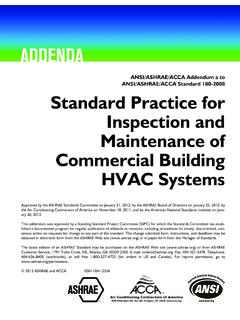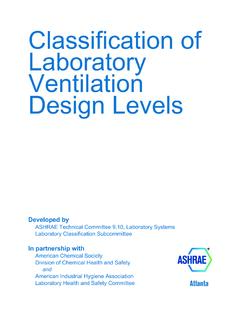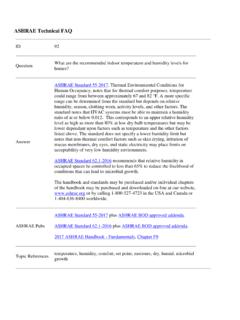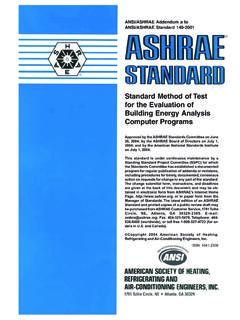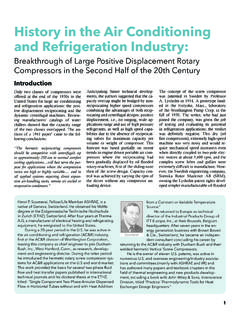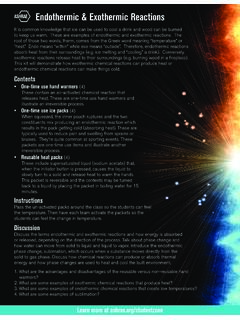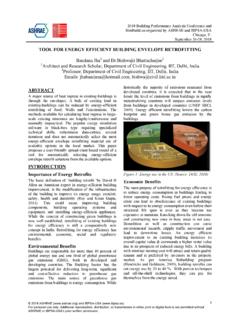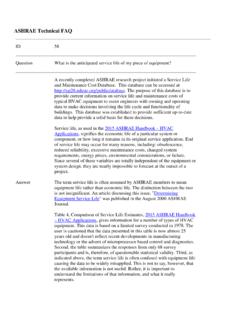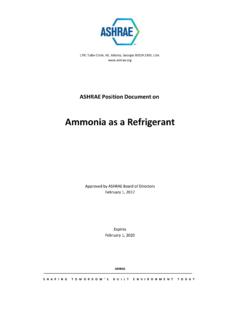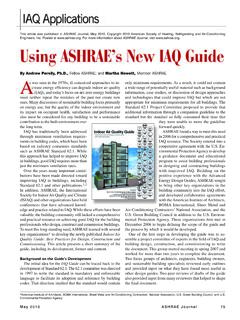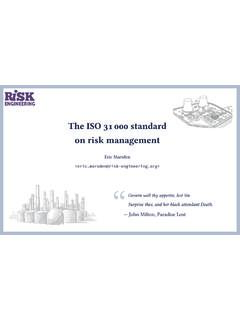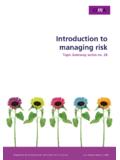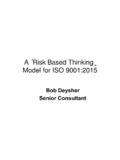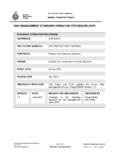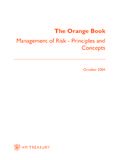Transcription of Risk Management For Legionellosis - ashrae.org
1 ASHRAE JOURNAL OCTOBER 201514BY PAUL LINDAHL, MEMBER ASHRAE; BILL PEARSON, MEMBER ASHRAE; R. LEE MILLIES, , MEMBER ASHRAE TECHNICAL FEATUREPaul Lindahl is director of market development at SPX Thermal Equipment & Services. He is vice chair of ASHRAE SSPC 188. Bill Pearson is vice president of consulting and technical services at Southeastern Laboratories, Inc., a member of SSPC 188, and Association of Water Technologies liaison to ASHRAE. R. Lee Millies, , is president at Millies Engineering Group and is a member of SSPC Management For LegionellosisANSI/ASHRAE Standard 188, Legionellosis : Risk Management for Building Water Systems, was published in June.
2 This long-awaited document establishes minimum Legionellosis risk Management requirements for building water systems. The standard establishes particular requirements for design engineers when they are involved in new build-ings, renovations, additions or modifications to existing buildings. The design engineer first needs to evaluate which requirements of the standard apply to their project. This evaluation determines if the project contains any of the following building risk factors: Multiple housing units with one or more centralized hot water systems; Contains more than 10 stories (including levels below grade); Health-care facility with patient stays over 24 hours; Facilities that house or treat immune-compro-mised, at-risk occupants such as those being treated for burns, organ transplant, chemotherapy, chronic lung disease, diabetes.
3 And Facilities designated for housing occupants over age any of these factors are present, then the design engineer needs to comply with Section 8 requirements in the standard with regard to potable water, both for hot and cold water evaluation also determines if the project contains one or more of the following system components: Cooling towers or evaporative condensers; Whirlpools, spas, ornamental fountains; Humidifiers, air washers, atomizers, misters; and Other nonpotable water systems or devices that have the potential to release water aerosols, such as ice any of these system components are present, then the engineer needs to comply with the relevant por-tions of Section 8 of the standard for those system components in addition to any potable water system requirements necessary as a result of building risk fac-tors in the list above.
4 Section 8 is discussed later in this article was published in ASHRAE Journal, October 2015. Copyright 2015 ASHRAE. Posted at This article may not be copied and/or distributed electronically or in paper form without permission of ASHRAE. For more information about ASHRAE Journal, visit 2015 ASHRAE JOURNAL15 Standard 188 applies also to the construction and operation phases of a project, as well as to operation and maintenance of existing buildings. Background on the StandardThe term Legionellosis refers to two illnesses, each contracted from exposure to Legionella bacteria.
5 The more severe form, when pneumonia results, is called Legionnaires disease (LD). An estimate by the Centers for Disease Control is 8,000 to 18,000 cases of LD per year in the United States, with more than 10% of those cases becoming fatal. It is important that require-ments be in place to manage risk of exposure to these bacteria from building water systems, where a signifi-cant percentage of the exposures occur. A less-severe illness known as Pontiac Fever, which has flu-like symp-toms, can also be caused by Legionella.
6 The risk of disease or illness from exposure to Legionella bacteria is not as simple as the bacteria being present in a water system. Other factors that contribute to the risk are environmental conditions that promote the growth and amplification of the bacteria in the system, a means of transmitting this bacteria (via water aerosols generated by the system), and the ultimate exposure of susceptible persons to the colonized water that is inhaled or aspirated by the host providing a pathway to the lungs. The bacteria are not transmitted person-to-person, or from normal ingestion of water.
7 Susceptible persons at high risk for Legionellosis include, among others, the elderly, dialysis patients, persons who smoke, and persons with medical conditions that weaken the immune system. The development of the standard spanned over a 10 year period, beginning in 2005, and published June 26, 2015. Figure 1 shows a timeline of the development of Standard 188-2015. In the course of that time, a balanced committee of experts produced five public review drafts, responding to comments and improving the document at each step.
8 With the final version, a consensus process standard for Legionellosis risk Management of building water systems was produced. The document is written in code language, so that it can be adopted as desired by government bodies (see NYC Responds to Outbreak sidebar). ASHRAE standards are otherwise voluntary. What s in the Standard?Standard 188 is intended for use by owners and man-agers of human-occupied buildings, and those involved in the design, construction, installation, commission-ing, operation, maintenance and service of centralized building water systems and standard specifies minimum Legionellosis risk Management requirements for human-occupied build-ings, not including residential, and their associated potable and nonpotable water systems.
9 Specific compliance pathways are defined in the stan-dard for the following groups: building designers, build-ing owners, and health-care Responds to OutbreakIn August, investigators discovered that a cooling tower at the Opera House Hotel in New York City was the source of a nearly monthlong outbreak of Legion-naires disease that caused 12 deaths and more than 120 cases of infection due to Legionellosis . During the search for the source, 14 other cooling tow-ers were found to be infected at other building sites. No city records were kept that indicated which buildings have cooling response to the outbreak, the New York City Coun-cil adopted legislation that requires adherence to part of ANSI/ASHRAE Standard 188-2015, Legionellosis : Risk Management for Building Water York City is considered the first major city to regulate cooling towers.
10 The legislation addresses reg-istration and inspection of cooling towers. It requires owners to create and file a plan to maintain equipment to comply with Sections 5, 6 and of the standard. Section 5 deals with building surveying, Section 6 with general requirements, while Section lists common tasks and steps for items such as new system start-up and seasonal shutdowns, general system maintenance, water treatment, disinfection plans, etc. Michael Patton, a member of the committee who wrote the standard, testified before the Council on behalf of ASHRAE.
